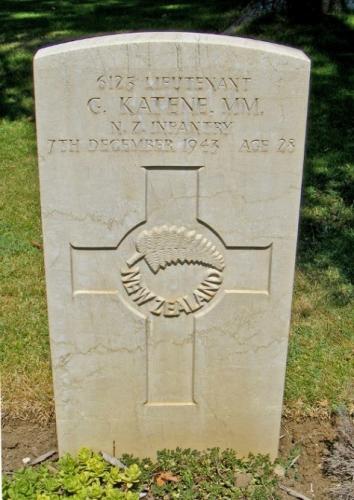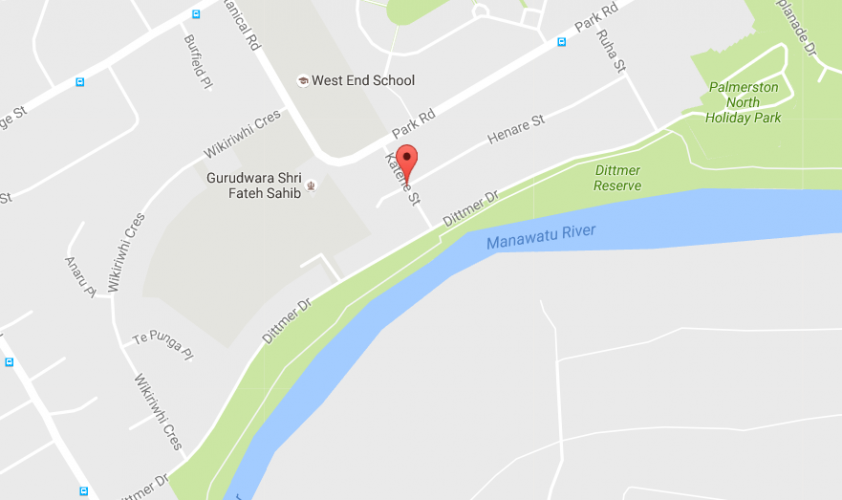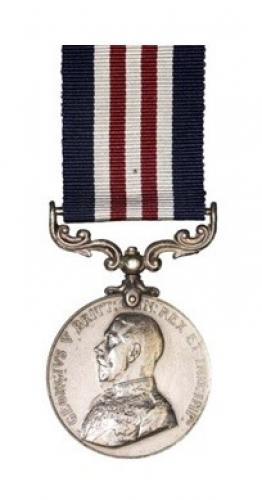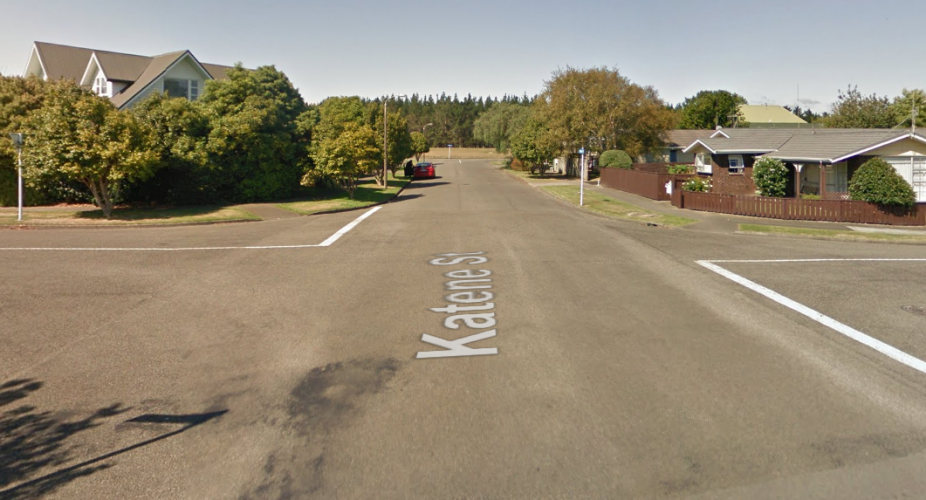094 Katene Street Palmerston North, street scene 2017
Reason for the name
Originally named Mahia Street, a Special Committee meeting on 22 March 1965 agreed that the name should be changed to Katene Street in honour of Lieutenant George Katene MM, 28th Maori Battalion
Prior to its subdivision the land known as Awatapu was a golf course and grazing area situated next to the Manawatu River. In order to free up land for residential development and increase revenue, a Council meeting of 16 April 1963 resolved to subdivide the area via “disposal of sections through Land Agents at pre-determined figures fixed by the Council”. The new Awatapu College had to be allowed for, and the old Awatapu Golf Links shifted upstream to Brightwater Terrace, which then became the Palmerston North Golf Club. The main access road through the area was at first known as Awatapu Avenue.
Katene Street lies at the centre of the Awatapu subdivision and runs perpendicular between Park Road and Dittmer Drive. It is intersected by Huata Place to the west and Henare Street to the east. It is home to 13 residential properties, with the Manawatu River flowing to the south and the historic Savage Crescent lying to its north
As part of the process of subdividing and naming streets, George Dittmer was contacted in late 1964 to give his thoughts on the naming of streets after 28th Māori Battalion soldiers as a commemoration of their service to their country. Dittmer provided a comprehensive list of soldiers who had served under him which was later utilised by the Council to adopt further street names in the Awatapu subdivision. After consultation and further correspondence with the Palmerston North City Council it was decided that all of the streets in the area would be renamed. Originally named Mahia Street, a Special Committee meeting on 22 March 1965 agreed that the name should be changed to Katene Street. The final resolution renaming the streets in the Awatapu subdivision was passed by Council on 22 November 1965 and took effect from 1 February 1966.
Author: Evan Greensides, Heritage Assistant for Palmerston North City Library.
George Katene was born in Porirua on 27 September 1915. The son of Te Aroha and George Katene and brother to Wikitoria Katene, George identified with Ngati Toa iwi and Ngati Tu hapū and was raised as part of The Church of Jesus Christ of Latter Day Saints. George grew up and lived in the Porirua region, obtaining his 4th standard proficiency and eventually going on to work for the Wellington Harbour Board as a labourer. He signed up to the Territorials in 1933 at the age of 18, and upon the outbreak of the Second World War had 6 years of experience in the force.
On 4 October 1939 the government of Prime Minister Michael Savage announced the intention to raise an all-volunteer Māori battalion. George enlisted in Wellington on 9 November, being sent to Trentham military camp 3 weeks later to begin his training as part of the first intake of 146 prospective Māori officers and NCOs. As the First Echelon had already entered camp, the men who entrained that day would form part of the Second Echelon. On 24 January, George and the other men of the 28th Māori Battalion were sent from Trentham to Palmerston North to begin training with the men they would eventually command. The next day George was promoted to temporary sergeant, a rank which was made permanent 2 weeks later.
For the next 3 months George helped to train the men of the 28 Māori Battalion, breaking down previously held tribal cordons and forming a cohesive fighting unit. At the end of its training, the battalion held a farewell parade for Palmerston North on 29 April 1940, then entrained for Wellington and left New Zealand for Scotland on 2 May. The rest of the year was taken up with training and moving around military camps such as Ewshott, Dogmersfield, Wichling and Farnham. On 4 January 1941 the battalion again boarded ships, this time heading to Port Tewfik and then the camp at Garawi where they spent a fortnight training learning to live through the heat, sandstorms and flies before heading to the battlefield in Greece as part of Lustre Force.
It was in early April that Sergeant Katene, leading the battalion’s mortar platoon, would take part in his first action against the enemy at in the Katerini Plains. Although the battalion put up stiff resistance, they were soon forced to withdraw in to the ports of southern Greece and evacuated to Crete. It was for his actions and leadership throughout the campaign in Greece that George would later be awarded the Military Medal (MM). There they would find no respite, as German forces invaded the island on 20 May. Although George and the men under his command would be spectators on the first day, they would play a pivotal role in the counterattack on Maleme Aerodrome two days later. It was during this assault that George sustained grenade wounds to the left buttock and thigh. He was evacuated by ship on 27 May and reached hospital in Egypt in early June, eventually spending 4 days recuperating from surgery.
After being sent to the battalion’s training company throughout July and then back to his position at the front, George was promoted to warrant officer second class on 25 August. The battalion spent the rest of the year defending the line in Libya, with the notable defence of Fort Musaid and later attack on Point 181 near Gazala, before returning to Egypt in December. In March 1942 George and the battalion, attached to 2 NZ Division, was sent to Syria for rest and recuperation. Upon their return to Egypt in June to reinforce the front line against Rommel’s latest attack, George was made a temporary 2nd lieutenant, a promotion which would be made permanent on 27 June.
Throughout the period July to August 1941 the battalion became involved in skirmishes around El Mreir and the Munassib Depression in the lead up to the Second Battle of El Alamein. During this time George was marched in to the battalion’s training company to develop the skills he would need as an officer – he arrived back with the battalion’s main body just in time to participate in Montgomery’s offensive at El Alamein at the end of October. It was here that the battalion was committed to the assault on Miteiriya Ridge and the follow-on piercing of the gap created in the Axis lines on 2 November during Operation Supercharge. While 2nd Lieutenant Katene was in charge of 17 Platoon due to casualties suffered by the battalion during the offensive, he was replaced by Lieutenant Ornberg and resumed his original command of the mortar platoon on 22 December.
On 22 January 1943, George and the rest of 28th Māori Battalion captured Tripoli, an advance which had taken them deep into Libya. Here they rested before once again being sent into battle, becoming involved in the successful defence of Medenine in March. Following on two weeks later, the battalion would face its toughest challenge yet with the assault on Point 209 where fellow soldier 2nd Lieutenant Moana-Nui-a-Kiwa Ngarimu would earn his posthumous Victoria Cross. With great difficulty George and the men of the mortar platoon attempted to support the assault on the ridge, but the range was too short and many shells never reached their target. After finding their range late in the day, George and the mortar platoon were able to silence the Axis support weapons and the battalion finally won the ridge from enemy hands. On 7 and 8 May, the Māori Battalion, now under the command of Lieutenant-Colonel Reta Keiha, carried out its final operation of the North African Campaign. The fighting in Tunisia ended on 13 May with the surrender of 275,000 Axis troops, whereupon George and his men made the long trek back to Maadi camp for a well-deserved rest.
With the Māori Battalion back at Maadi Camp in Egypt, the following months were spent cleaning up, training new arrivals and refilling the battalion’s depleted manpower after the long and arduous North African Campaign. News reached the unit of the posthumous award of the Victoria Cross to 2nd Lieutenant Moana Ngarimu. George is noted multiple times in the battalion diary at this time of presiding over a court of enquiry into actions on base, interspersed with numerous trips off-base on furlough to Cairo and its surrounds. On 27 June George was promoted to the rank of full lieutenant. In mid-September the battalion undertook a 161 kilometre route march to Burg el Arab, a manoeuvre which was designed to harden the troops for the coming winter campaign in Italy. With Lieutenant Katene in charge of the Marching Transport Group, the battalion completed the trek in 4 days.
On October 17th the 28th Māori Battalion left Egypt to take up an operational role in Italy. They were part of the 22,000-strong Second New Zealand Division which was to renew its association with the British Eighth Army. Arriving in Italy on October 22, George and the battalion set up base at Taranto before being tasked with breaching the Gustav Line near Orsogna. As they crossed the Sangro River and approached the town the battalion became involved in its first fighting in Italy on 7 December. As part of the larger 2 NZ Division, the battalion attempted to make a right flanking attack to cut the Orsogna to Poggiofiorito Road. George was conferring on possible targets for the mortars with 2nd Lieutenant Tomoana before leaving to visit A Company when he was struck down by enemy fire and killed. As one of the few foundation members of the 28th Māori Battalion still serving, his loss was badly felt.
George’s death was listed on Casualty List # 593 in the New Zealand Gazette on 20 December 1943. On 23 January 1944 a memorial service was held at the marae at Porirua in honour of both George and other men of 28th Māori Battalion who had paid the ultimate sacrifice. George Katene remains in Italy, buried in plot 12, row H, grave 14 at the Moro River Canadian War Cemetery.
Honours and Awards
- Military Medal
- 1939-1945 Star
- Africa Star with 8th Army Clasp
- Italy Star
- Defence Medal
- War Medal, 1939-1945
- New Zealand War Service Medal








